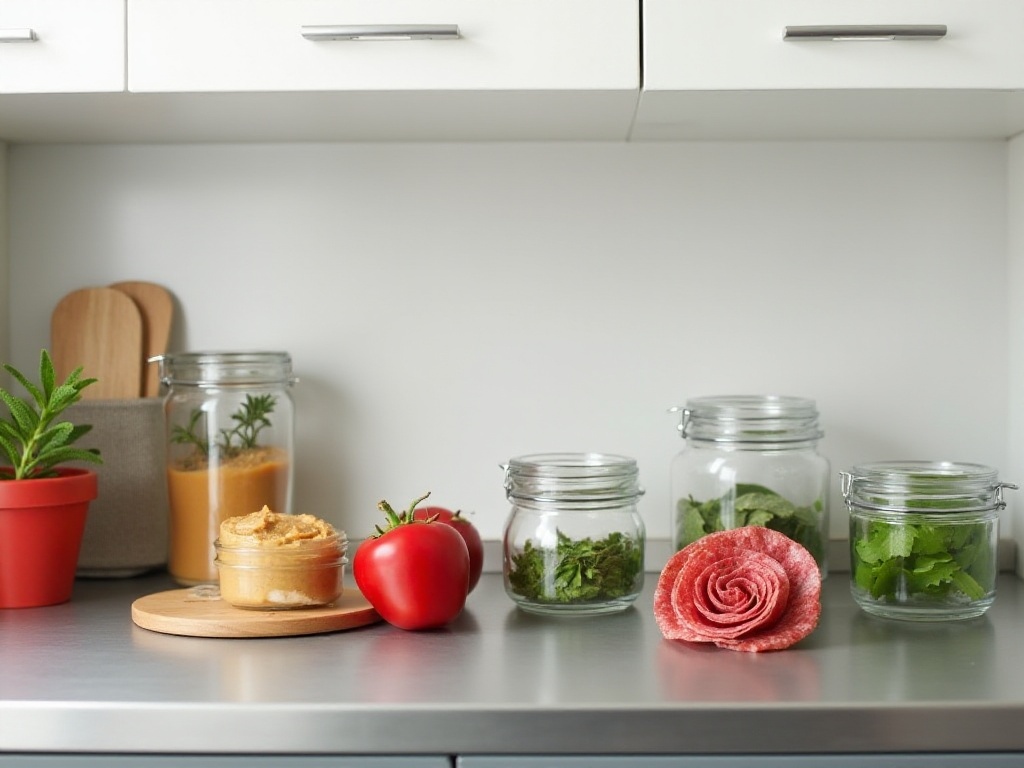
Opening Chat
To be honest, as a young person who just moved out, I was overwhelmed by kitchen work. When I lived with my parents, cooking seemed so easy, but once I started doing it myself, I realized it wasn't that simple. From burning food to cutting myself, the kitchen was my nightmare. It wasn't until I started researching various kitchen techniques that I slowly found my way. After years of exploration and practice, I've summarized some particularly useful tips to share with everyone.

Ingredient Preparation
When it comes to handling ingredients, it's a love-hate relationship. I remember when I first started cooking, just dealing with herbs could drive me crazy for hours. Those tiny leaves were a pain to pick one by one, and it was especially easy to pull the stems along. Later, I found an amazing method online: pull herb branches backward through a funnel's small hole or fine mesh, and the leaves fall right off while the stems stay on the other side. The first time I tried this method, I almost jumped with joy - it was so convenient!
Then there's the garlic problem. Peeling garlic used to frustrate me - it was time-consuming and left my hands smelling terrible. Now I put the whole garlic head in a sealed container and shake it vigorously, which separates the cloves and loosens the skin. Then I soak the cloves in warm water for a while, and the skin peels off easily. This method really saves time and effort - no more staring helplessly at garlic heads.
Peanut butter seems simple, but using it properly requires technique. Initially, I was always annoyed by the oil layer and would make a mess when stirring. Later, I discovered that storing the jar upside down allows the oil to naturally permeate through, making the peanut butter more uniform. Now I always store peanut butter upside down, eliminating the need for vigorous stirring.
Handling onions is also a skill. Cutting onions used to make me cry like I was in a soap opera. Later, I learned a trick: refrigerate the onion before cutting and keep a small piece of bread in your mouth while cutting - no more teary eyes. This trick works every time, and now cutting onions is completely stress-free.
Storing ginger is another challenge. It dries up and wrinkles after a few days, but you can't use it all at once. Now I slice ginger, put it in a sealed bag, squeeze out the air, and freeze it. This makes it convenient to use and preserves it for a long time.
Bell peppers and chili peppers also have their tricks. Many people don't know that after removing the stem, making a cut down the middle and scraping out the seeds with a spoon not only reduces spiciness but also helps the peppers absorb flavors better. This tip is particularly useful for stir-fries and cold dishes.

Storage Solutions
Kitchen storage is truly a major subject. My kitchen isn't big, but it looks neat and organized thanks to some storage tricks.
Let's start with freezer bag tips. I used to make a mess pouring soup or sauce into freezer bags. Now I place the bag vertically in a measuring cup, folding the opening over the rim - this makes pouring anything much easier and keeps the table clean. This method is truly a storage breakthrough, especially for clumsy people like me.
Cheese storage also requires technique. Initially, I just wrapped it in plastic bags, but it would mold within days, wasting money. Later, I learned to wrap it first in wax paper, then in plastic wrap, which keeps cheese fresh much longer. Using different colored wax paper for different types of cheese also makes everything look neat and organized.
Storing seasonings is crucial too. I keep frequently used seasonings on a rotating rack, making it easy to find what I need while cooking without rummaging through cabinets. Small spice bottles are attached to the refrigerator's side with magnets, saving space while remaining accessible.
As for various kitchen tools, I use transparent storage boxes for categorization. One box for peelers and bottle openers, another for measuring spoons and strainers, each labeled clearly for easy access.
Cleaning Tips
Honestly, cleaning was my biggest headache. Especially when I first started cooking, the kitchen looked like a battlefield after each meal.
Cleaning frying pans is a major issue. Once, after grilling steak, the pan bottom was completely blackened and wouldn't scrub clean. Then I tried this method: place the pan upside down with a wet paper towel underneath, then pour in a mixture of baking soda and white vinegar. After fifteen minutes, those stubborn burnt spots could be easily wiped away! This method is a lifesaver, and I now use it regularly for various difficult-to-clean cookware.
Oven cleaning also has its techniques. I used to use commercial cleaners, but they weren't very effective and had strong odors. Now I add baking soda to the cleaner, spray it evenly on the oven walls using a spray bottle, let it sit for twenty minutes before wiping. This not only removes grease easily but also avoids harsh smells.
Microwave cleaning has its tricks too. I fill a large bowl with water, add some lemon slices, and heat on high for five minutes. The steam softens stubborn stains, and the lemon freshens the air. After the microwave cools, wiping is incredibly easy.
Cleaning and deodorizing cutting boards is important. After cutting onions, ginger, garlic, or raw meat, I scrub the board with salt and lemon slices for disinfection and odor removal. After rinsing and drying, I sprinkle cornstarch to prevent wooden boards from cracking.
Sink cleaning is also technical. I clean the sink weekly with baking soda and white vinegar, which removes water stains and clears drains. This method also helps prevent cockroach infestations, especially in summer.
Kitchen counter cleaning is crucial. I wipe counters with warm water and food-grade vinegar, which disinfects without leaving chemical residue. I do this after cooking each day to maintain kitchen cleanliness and hygiene.

Creative Plating
Honestly, I used to think plating was just dumping food onto a plate. But later I discovered that with a little thought, ordinary dishes can become quite elegant.
Sausage roses are a particularly creative plating method. Overlap and roll sausage slices, secure with toothpicks, then fry them to create beautiful rose shapes. The first time I did this at a friend's gathering, everyone was amazed and asked me to teach them.
Fruit plating also has its techniques. Instead of cutting oranges in half, slice them horizontally and arrange them overlapping - it looks much more sophisticated. Apples can be thinly sliced and arranged in a fan shape, sprinkled with crushed nuts for instant elegance.
Salad plating is interesting too. I like to arrange different colored vegetables in sections - purple cabbage, carrots, corn in different areas of the plate, creating a colorful picture. Drizzling dressing on top enhances both aesthetics and taste.
For chips and dip, I now pour the sauce directly into the chip bag - it's not only convenient but ensures every chip gets evenly coated. This method is especially popular at parties, with everyone agreeing it's more enjoyable.
Dessert plating is important too. For simple ice cream, I use a heated scoop to create perfect spheres. Then I decorate the plate with chocolate sauce patterns and mint leaves, making it instantly elegant.

Final Thoughts
Honestly, these simple tips can make kitchen life easier and more enjoyable. These techniques have been instrumental in my transformation from a kitchen novice to someone who can confidently handle various cooking challenges.
The kitchen isn't just a place for cooking; it's a space for creating food and happiness. Each new technique brings different surprises. I now truly enjoy my time in the kitchen, knowing I'll create satisfying dishes.
I hope everyone can find their own kitchen tricks and make cooking a joyful experience. Next time, we'll discuss living room storage secrets to make every corner of your home neat and organized.







